Did you know that a properly configured Dolby Atmos system can support up to 64 unique speaker feeds? This advanced technology takes your home theater experience to a whole new level. Unlike traditional surround sound, Atmos creates a three-dimensional audio environment that envelops you in sound from every direction.
Setting up your system correctly is crucial for achieving the best results. Proper speaker placement ensures balanced sound and maximizes the immersive effect. Whether you’re watching movies or listening to music, every detail comes to life with precision and clarity.
This guide will walk you through the essentials of configuring your setup. From calibration to optimal positioning, you’ll learn how to make the most of your equipment. With expert tips and technical insights, you’ll create a listening environment that feels like a professional studio.
Key Takeaways
- Dolby Atmos systems support up to 64 unique speaker feeds for immersive audio.
- Proper speaker placement is essential for balanced sound and maximum impact.
- Calibration ensures optimal performance and enhances the listening experience.
- Atmos technology offers a three-dimensional soundstage, surpassing traditional surround sound.
- Expert tips and technical details simplify the setup process for your home theater.
Understanding Dolby Atmos Technology
With Dolby Atmos, audio moves freely around you, creating a lifelike three-dimensional effect. This technology goes beyond traditional surround sound by adding height channels and object-based audio. The result is a soundscape that feels natural and immersive, whether you’re watching a movie or listening to music.

What Is Dolby Atmos?
Dolby Atmos is an advanced audio system that uses object-based sound to place audio elements precisely in your space. Unlike traditional channel-based systems, it allows sounds to move dynamically, creating a more realistic experience. Height channels add a vertical dimension, making it feel like sound is coming from above or around you.
Traditional setups, like 5.1 or 7.1 systems, are limited to horizontal sound placement. Dolby Atmos, however, supports up to 34 speakers in a home theater, including overhead modules. This flexibility ensures every detail is heard exactly where it should be.
Benefits Over Traditional Surround Sound
One of the biggest advantages of Dolby Atmos is its ability to create a three-dimensional sound field. Object-based audio lets filmmakers and sound designers place sounds anywhere in the room, enhancing the realism of the experience. This is a significant upgrade from conventional systems, which rely on fixed channels.
Another benefit is improved spatial accuracy. Sounds can move seamlessly from one point to another, making action scenes more thrilling and dialogue clearer. Whether it’s rain falling from above or a car speeding past, every element feels more authentic.
“Dolby Atmos brings a new level of immersion to home theater, making it feel like you’re part of the action.”
Understanding these fundamentals is essential before setting up your system. With the right configuration, you can unlock the full potential of Dolby Atmos and enjoy a truly cinematic experience at home.
Exploring the Benefits of a Dolby Atmos Home Theater
Transform your home theater into a cinematic haven with Dolby Atmos technology. This advanced system creates a three-dimensional soundscape that immerses you in every scene. Whether you’re watching a blockbuster movie or listening to your favorite music, the experience is unparalleled.
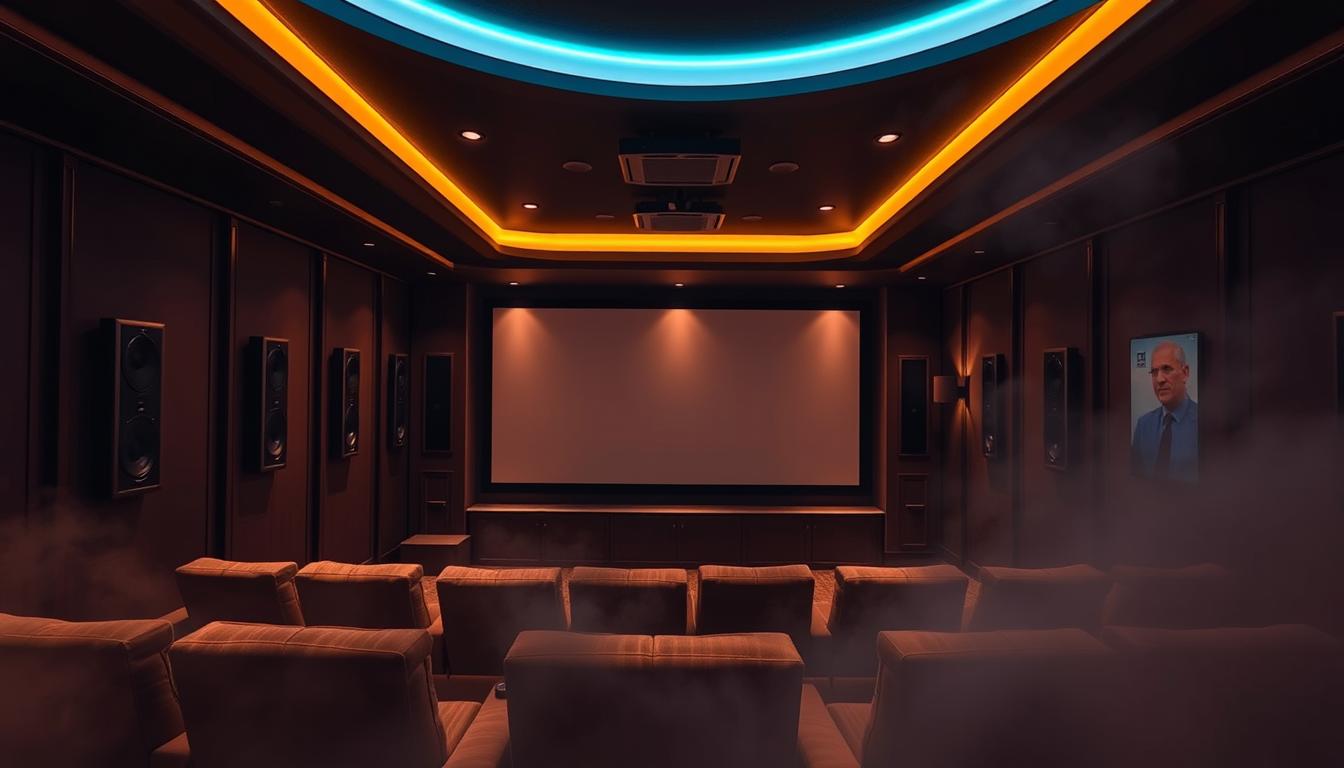
Immersive Audio Experience
Dolby Atmos delivers precise sound localization, making it feel like audio is coming from all around you. Overhead speakers add a vertical dimension, enhancing the realism of rain, helicopters, or other effects. This setup ensures every sound is heard exactly where it should be.
Carefully calibrated speaker placement is key to maximizing the system’s potential. Proper configuration ensures balanced sound and creates a seamless audio environment. This attention to detail enhances your engagement with movies and music alike.
- Overhead speakers create a balanced three-dimensional sound field.
- Object-based audio allows for a personalized listening experience.
- Precise sound localization makes every scene more immersive.
The system’s object-based architecture lets filmmakers place sounds anywhere in the room. This flexibility ensures a dynamic and lifelike experience. From subtle whispers to thunderous explosions, every element is rendered with clarity.
“Dolby Atmos transforms your home theater into a sensory masterpiece, making you feel like you’re part of the action.”
Upgrading to a Dolby Atmos home theater is a game-changer. The technology’s ability to create a personalized and immersive experience sets it apart from traditional systems. With the right setup, you’ll enjoy a new level of audio realism.
Planning Your Home Theater Room Layout
The layout of your room plays a critical role in achieving the best Dolby Atmos experience. Room acoustics and dimensions directly impact how sound travels and reflects, influencing the overall performance of your system. Proper planning ensures a balanced sound field and maximizes the immersive effect.
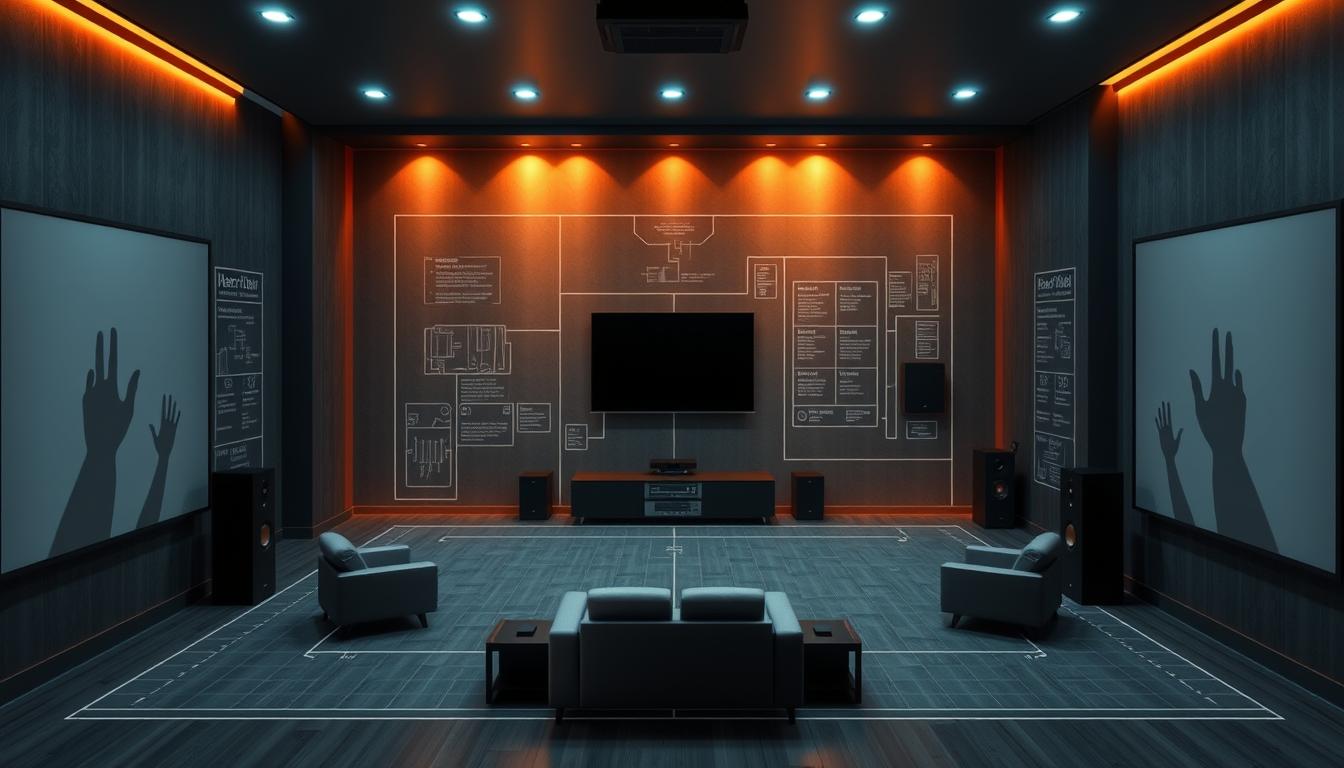
Room Acoustics and Dimensions
Room shape and size affect sound reflections and clarity. For example, a rectangular room with dimensions like 16 feet by 13 feet can create challenges for speaker placement. Strategic positioning of speakers relative to walls and reflective surfaces helps minimize distortions and enhances audio quality.
Consider the distance between speakers and the listening position. A 7.1.4 configuration, with 7 speakers at ear level and 4 overhead, works best in larger spaces. Smaller rooms may benefit from a 5.1.2 setup, which is more affordable and easier to manage.
Addressing Furniture and Obstructions
Furniture and structural elements can block or alter sound propagation. Place your main left and right speakers at a 45 to 60-degree angle from the listening position for optimal sound separation. Avoid placing large objects like bookshelves or cabinets directly in front of speakers.
For side surround speakers, position them about 1 foot above ear level and slightly in front of the listener. This placement improves the surround effect and ensures a seamless audio experience. Rear speakers should be spread out at a 45-degree angle for balanced sound distribution.
By addressing these factors, you can create a room layout that enhances your Dolby Atmos system’s performance. Proper planning ensures every sound is heard exactly where it should be, delivering a truly immersive experience.
Speaker Placement Essentials
Achieving the perfect soundstage starts with precise speaker placement. Proper alignment ensures balanced sound and maximizes the immersive effect of your home theater. Whether you’re setting up a new system or optimizing an existing one, these guidelines will help you create a cohesive audio environment.
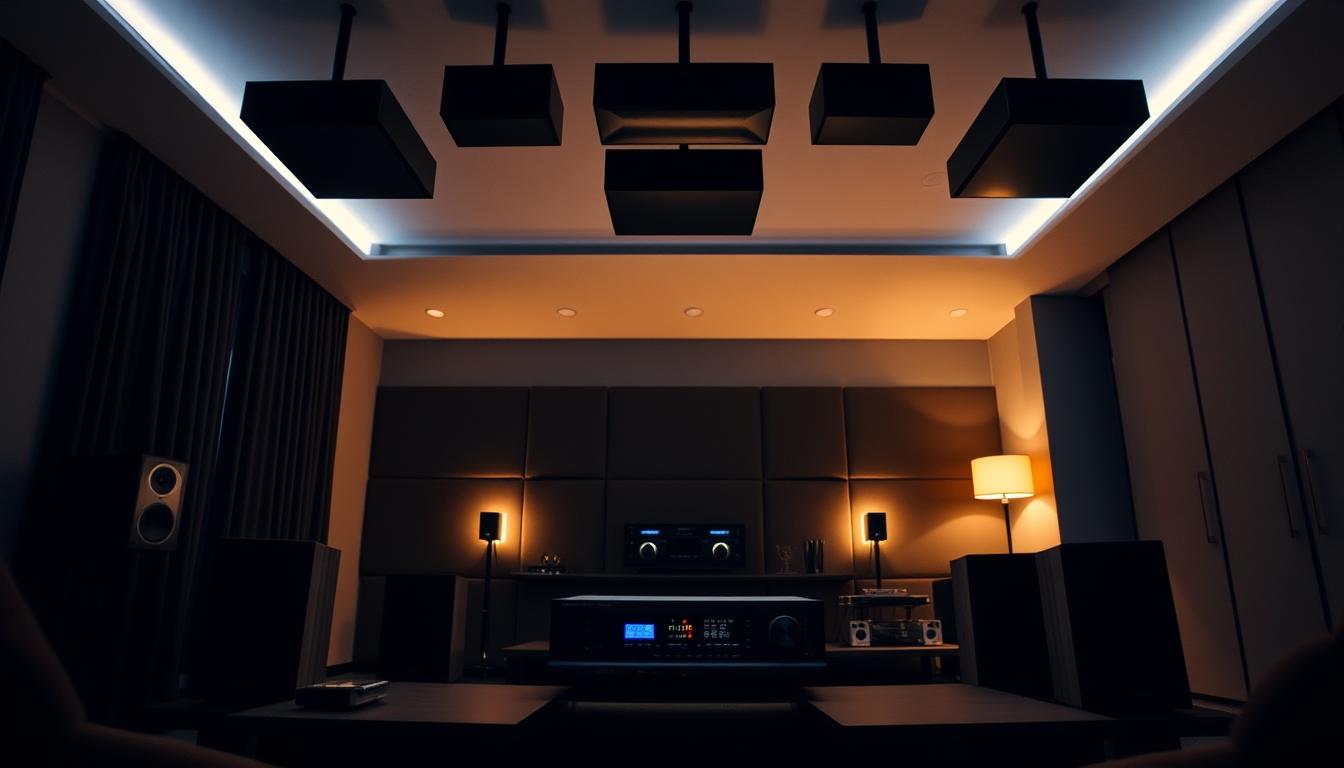
Front, Center, and Surround Speaker Alignment
Your front left and right speakers should form a 45 to 60-degree angle from the listening position. This toe-in technique improves sound imaging and dialogue clarity. Place the center channel directly above or below your screen, ensuring it aligns with the front speakers for seamless audio transitions.
Surround speakers should be positioned about 1 foot above ear level and slightly in front of the listener. This placement enhances the surround effect and ensures a balanced sound field. Avoid placing speakers too close to walls or furniture, as reflections can distort the audio.
Subwoofer Positioning Guidelines
Subwoofer placement is critical for even bass distribution. Avoid corners, as they can create boomy effects. Instead, experiment with positions along the front wall or near the center of the room. Use the table below for quick reference:
| Position | Effect |
|---|---|
| Front Wall Center | Balanced bass |
| Front Wall Corner | Boomy bass |
| Room Center | Even distribution |
Precise speaker placement is vital to unlocking the full potential of your Dolby Atmos system. By following these guidelines, you’ll create a listening experience that feels both natural and immersive.
Integrating Overhead and Height Speakers
Overhead and height speakers are the backbone of a true Dolby Atmos experience. These components add a vertical dimension to your audio, creating a soundscape that feels natural and immersive. Proper integration ensures every sound is heard exactly where it should be, enhancing your listening experience.
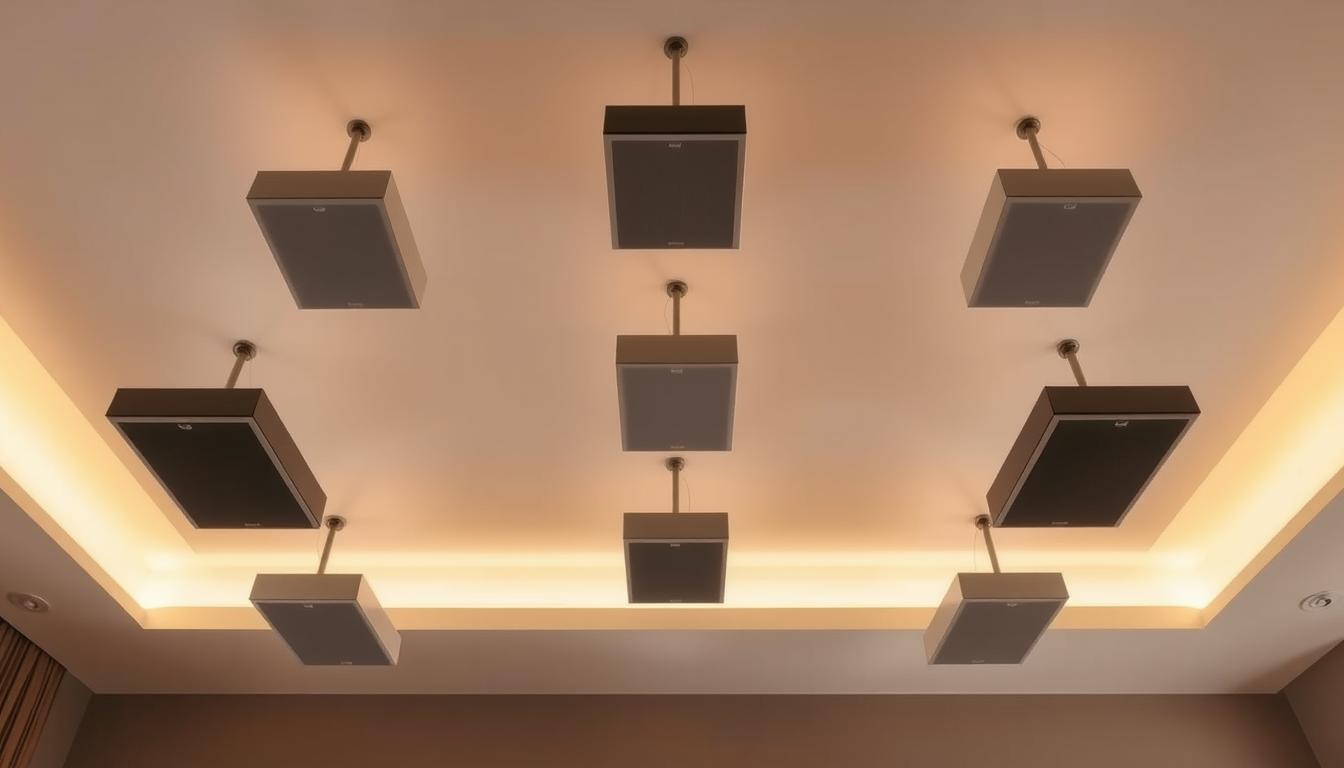
Ceiling Versus Height Modules
Choosing between ceiling-mounted speakers and dedicated height modules depends on your room and preferences. Ceiling-mounted options provide direct sound, ideal for rooms with higher ceilings. They offer precise placement and minimal sound loss, making them a popular choice for dedicated home theaters.
Height modules, on the other hand, are more flexible and easier to install. These speakers bounce sound off the ceiling, creating a similar overhead effect. While they may lose some efficiency due to reflections, they are a great option for rooms where ceiling installation isn’t feasible.
Optimal Vertical Positioning
Vertical positioning is critical for achieving the best sound reflection. Overhead speakers should be placed at a height two to three times the level of your ear-level speakers. This ensures sound travels naturally, creating a seamless immersive experience.
Maintaining consistent speaker heights is equally important. For example, if you’re using four height speakers, ensure they are evenly spaced and angled toward the primary listening area. This setup minimizes distortions and enhances the three-dimensional effect.
“Proper vertical speaker placement is key to unlocking the full potential of Dolby Atmos.”
Tailoring your vertical speaker configuration to your room’s dimensions and acoustics ensures a balanced and lifelike audio experience. Whether you choose ceiling-mounted speakers or height modules, careful placement is essential for maximizing the impact of your system.
How to Connect Dolby Atmos Speakers for Maximum Impact
Ensuring your Dolby Atmos system delivers its full potential starts with proper connections and calibration. A well-configured setup ensures every sound is heard exactly where it should be, creating a truly immersive experience. This guide will walk you through the essential steps to connect and calibrate your system for optimal performance.
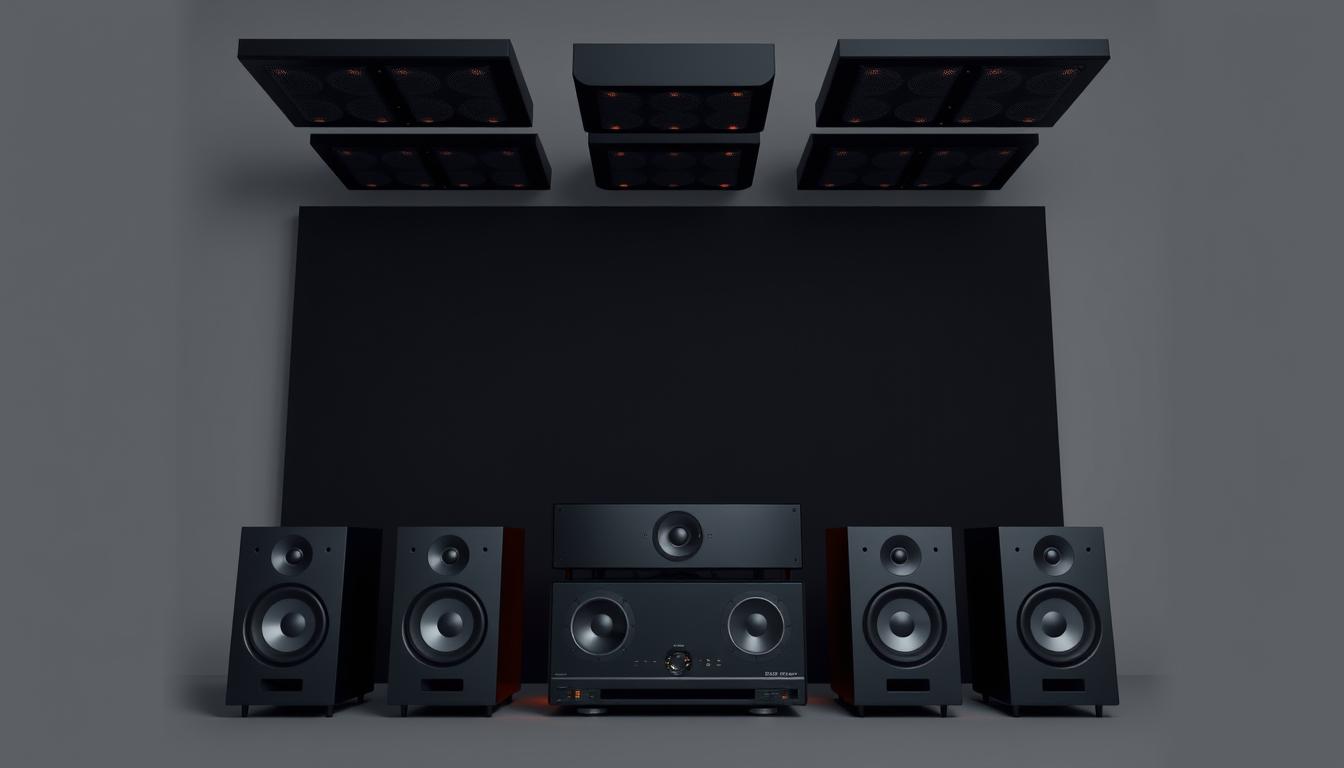
Step-by-Step Connection Guide
Begin by identifying the components of your system. Most setups include front, center, surround, and overhead speakers, along with a subwoofer. Here’s how to connect them securely:
- Front and Center Speakers: Place the front left and right speakers at a 45 to 60-degree angle from the listening position. Position the center speaker directly above or below your screen.
- Surround Speakers: Place these about 1 foot above ear level and slightly in front of the listener for optimal sound separation.
- Overhead Speakers: Mount these at a 30 to 55-degree angle above ear level for the best sound reflection.
- Subwoofer: Experiment with positions along the front wall or near the center of the room for even bass distribution.
Proper cable management is crucial. Use high-quality cables and ensure they are securely connected to your A/V receiver. For more details on optimal setup for Dolby Atmos ceiling, refer to our comprehensive guide.
Calibration and Level Matching Tips
Calibration ensures all speakers are balanced and working together seamlessly. Most A/V receivers offer automatic calibration tools, but manual adjustments can fine-tune the system further.
- Automatic Calibration: Use the built-in microphone and software to measure speaker distances and adjust levels automatically.
- Manual Adjustments: Test each speaker individually and adjust the volume to ensure consistent sound levels across the room.
- Level Matching: Ensure the subwoofer blends smoothly with the other speakers. Avoid overpowering bass by setting the crossover frequency appropriately.
“Proper calibration is the key to unlocking the full potential of your Dolby Atmos system.”
If you encounter issues, check for loose connections or incorrect settings. Troubleshooting common problems ensures your system performs at its best.
By following these steps, you’ll create a home theater setup that delivers a lifelike and immersive audio experience. Proper connections and calibration are essential for maximizing the impact of your Dolby Atmos system.
Component Systems Versus Sound Bar Solutions
Choosing the right audio setup for your home theater can significantly impact your listening experience. When deciding between component systems and sound bars, it’s essential to weigh the trade-offs in complexity, flexibility, and audio quality. Both options have unique advantages, but your choice will depend on your room size, budget, and personal preferences.
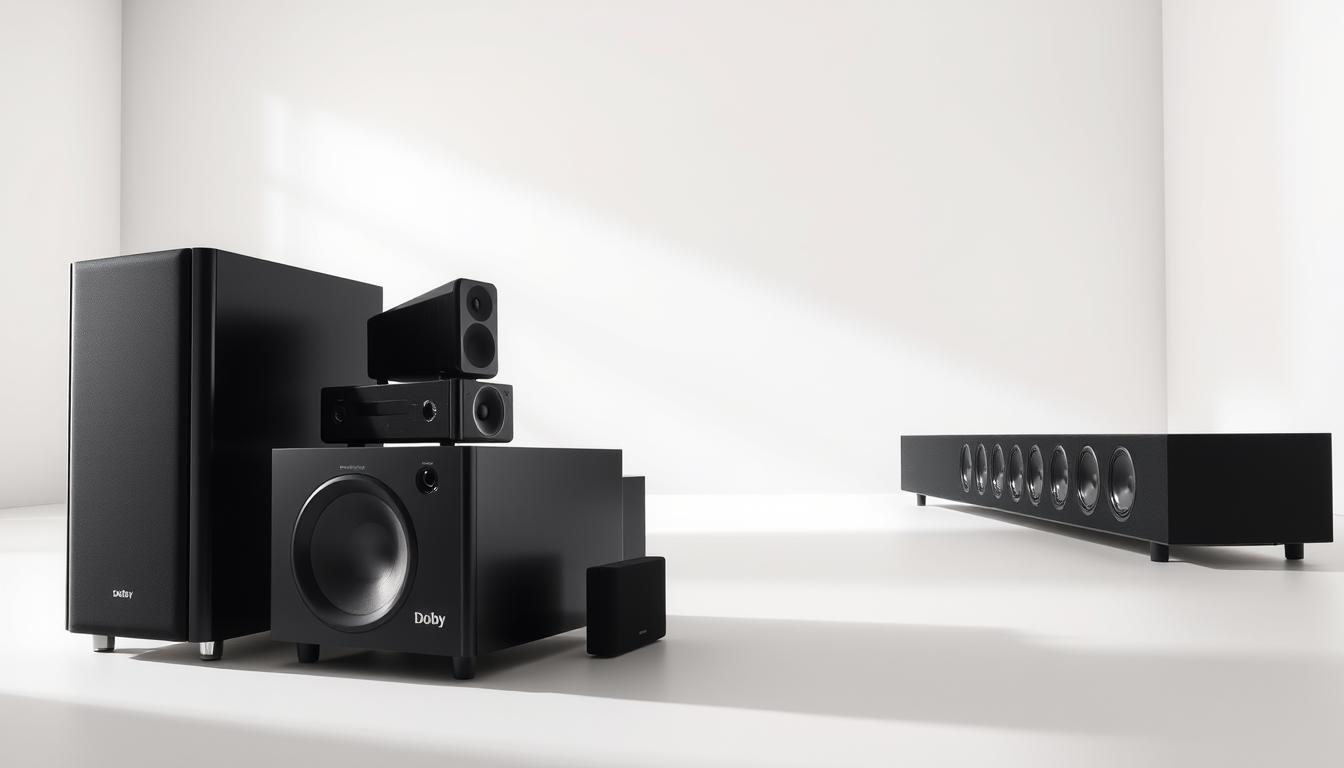
System Complexity and Setup Flexibility
Component systems offer unparalleled customization and directional control. These setups typically include multiple speakers, such as front, center, surround, and overhead units, along with a subwoofer. While this configuration provides a 360-degree sound experience, it requires careful placement and calibration. For larger rooms, a 7.1.4 setup with seven ear-level speakers and four overhead units can deliver exceptional immersion.
Sound bars, on the other hand, are designed for simplicity. Models like the Sonos Arc feature upward-firing drivers to simulate overhead effects, creating a massive soundstage with minimal setup. This makes them ideal for smaller spaces or those who prefer a clean, unobtrusive design. However, sound bars may not match the precise object-based audio of component systems.
- Component Systems: Offer full customization and directional control, ideal for larger rooms.
- Sound Bars: Provide a simpler setup with compact design, suitable for smaller spaces.
- Installation: Component systems require more time and effort, while sound bars are quick to install.
- Audio Quality: Component systems excel in immersive, object-based audio; sound bars focus on convenience.
When selecting your setup, consider factors like room size, budget, and aesthetic preferences. A hybrid solution, combining a sound bar with satellite speakers and a subwoofer, can also enhance your home theater experience without the complexity of a full component system.
“The right audio setup transforms your home theater into a sensory masterpiece, tailored to your space and preferences.”
By understanding the differences between component systems and sound bars, you can make an informed decision that maximizes your listening experience. Whether you prioritize customization or convenience, both options bring the magic of Dolby Atmos to your home.
Optimizing the Audio Channel Configuration
Optimizing your audio channel configuration ensures every sound reaches you with clarity and precision. A well-configured setup enhances the immersive quality of your home theater, making every detail stand out. Proper alignment and management of reflections are key to achieving this.
Direct Path to the Listener
Creating a direct sound path from your speakers to the listener improves clarity and imaging. Position your front left and right speakers at a 45 to 60-degree angle from the listening position. This toe-in technique ensures sound travels directly to your ears, enhancing dialogue and stereo separation.
The center speaker should align with your ear level when seated. This placement ensures dialogue remains clear and centered. Avoid placing speakers too close to walls or furniture, as these can block or distort the sound path.
Managing Reflections and Distance
Sound reflections can disrupt the immersive experience. To minimize this, manage speaker distance and orientation relative to walls and furniture. Surround speakers should be placed about 1 foot above ear level and slightly in front of the listener. This reduces reflections and improves the surround effect.
Use soft materials like thick curtains or rugs to absorb sound and reduce reflections. Hard surfaces like glass or brick walls can cause echoes, so consider acoustic treatments if needed. Here’s a quick reference for speaker positioning:
| Speaker | Position |
|---|---|
| Front Left/Right | 45-60° from listener |
| Center | Ear level, aligned with screen |
| Surround | 1 foot above ear level, slightly in front |
| Subwoofer | Front wall center or room center |
Fine-tuning your speaker outputs based on room acoustics and listener position ensures a balanced sound field. A well-optimized channel configuration results in more precise and engaging sound reproduction, enhancing your overall experience.
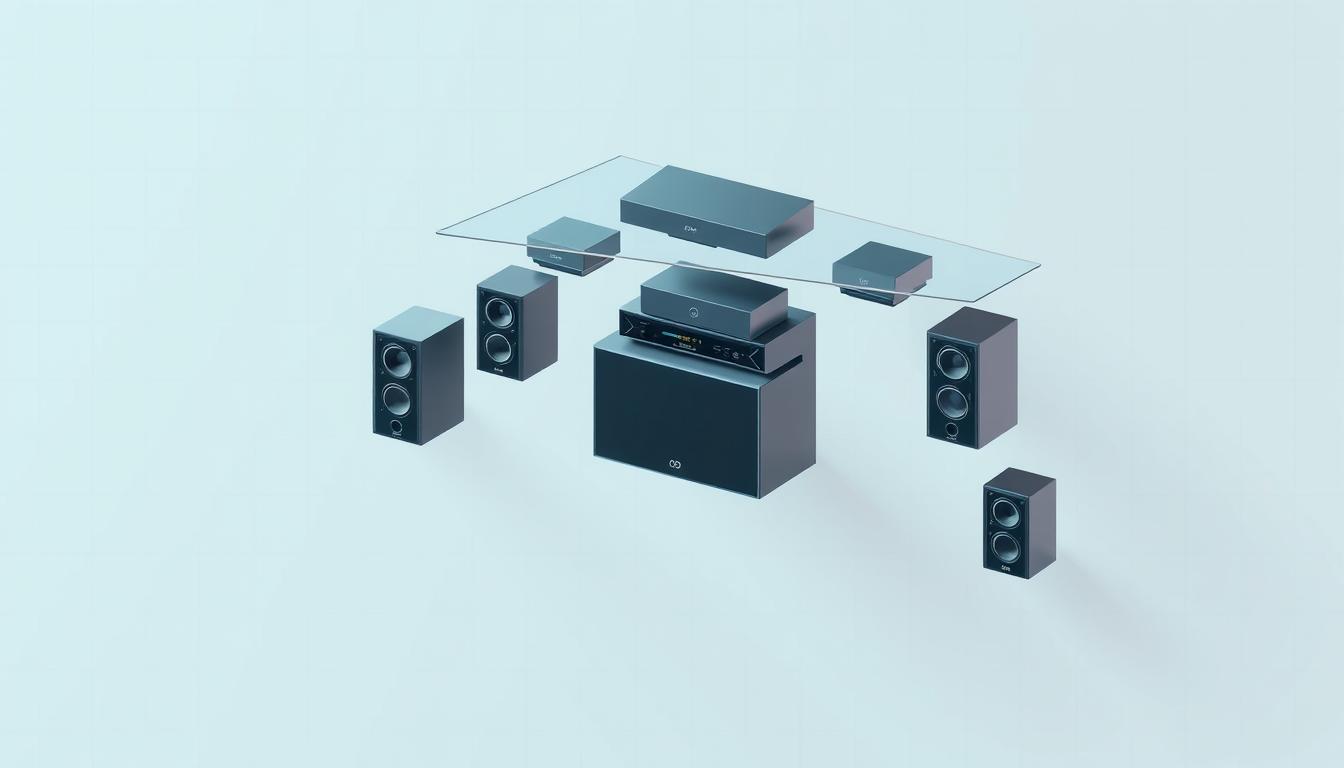
Level Matching and System Calibration Techniques
Calibrating your audio setup ensures every sound is balanced and immersive. Proper level matching and calibration are essential for creating a cohesive sound field. Whether you’re using automatic tools or manual adjustments, the goal is to achieve consistent output across all channels.
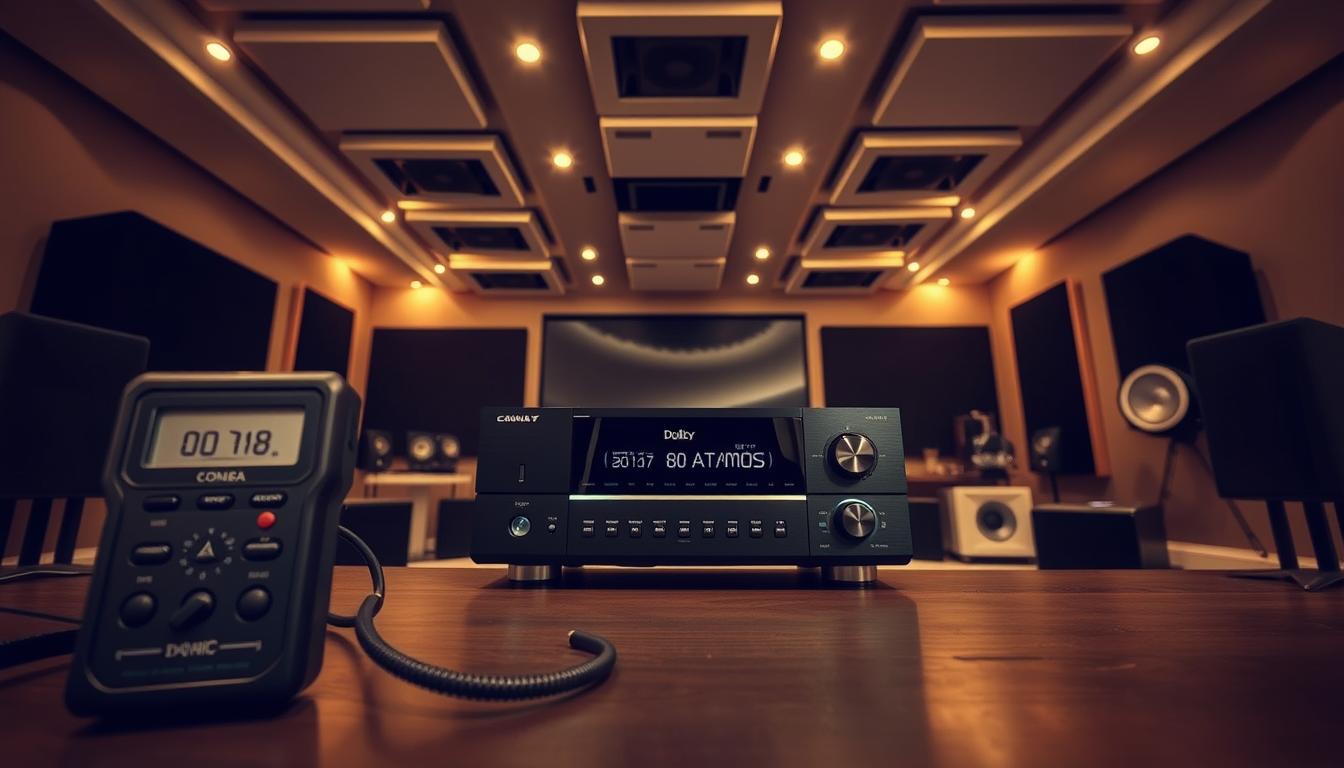
Automatic Calibration Options
Most modern A/V receivers come with built-in automatic calibration tools. These systems use a microphone to measure speaker distances and adjust levels accordingly. This process ensures that audio signals arrive at the listening position at the same time, creating a seamless experience.
Automatic calibration is ideal for beginners or those who prefer a quick setup. It eliminates guesswork and ensures a balanced sound field. However, manual adjustments can fine-tune the system further for optimal performance.
Manual Adjustment Best Practices
Manual calibration allows you to tailor your system to your room’s acoustics. Start by testing each speaker individually. Adjust the volume to ensure consistent sound levels across the room. Pay attention to the subwoofer, ensuring it blends smoothly with the other speakers.
Use test tones and metering tools to measure frequency levels and phase alignment. This step is crucial for preventing imbalances and achieving a cohesive sound field. Here’s a quick reference for calibration settings:
| Speaker | Calibration Setting |
|---|---|
| Front Left/Right | 45-60° angle, balanced volume |
| Center | Ear level, clear dialogue |
| Surround | 1 foot above ear level, balanced surround effect |
| Subwoofer | Front wall center, even bass distribution |
“Proper calibration is the key to unlocking the full potential of your audio system.”
By combining automatic and manual techniques, you can create a listening experience that feels both natural and immersive. Correct calibration ensures every detail is heard exactly where it should be, enhancing your overall enjoyment.
Leveraging Dolby Atmos for Music and Movies
Dolby Atmos transforms both movies and music into immersive experiences that feel alive. This technology creates a three-dimensional soundscape, making every scene and note more engaging. Whether you’re watching a blockbuster or listening to your favorite album, the experience is unparalleled.
Optimizing Audio for Cinematic Content
For movies, Dolby Atmos enhances spatial accuracy and dynamic sound movement. Explosions, footsteps, and dialogue are precisely placed, creating a lifelike environment. Overhead speakers add depth, making it feel like sound is coming from above or around you.
Tailoring your system for cinematic content involves specific techniques. Ensure your front and center speakers are aligned for clear dialogue. Surround and overhead units should be positioned to create seamless transitions. This setup ensures every element of the soundtrack is heard exactly where it should be.
- Height channels add a vertical dimension, enhancing realism.
- Dynamic sound movement makes action scenes more thrilling.
- Precise placement ensures dialogue remains clear and centered.
Creating a Spacious Music Experience
Music benefits from Dolby Atmos’ ability to create a spacious and enveloping soundstage. Artists can place instruments and vocals in three-dimensional space, making you feel like you’re in the studio or at a live concert. This technology brings a new level of depth to your listening experience.
To optimize your system for music, focus on speaker placement and calibration. Ensure your left and right speakers are positioned for balanced stereo separation. Overhead units should enhance the sense of space without overpowering the mix. Here’s a quick reference for optimal settings:
| Speaker | Position |
|---|---|
| Front Left/Right | 45-60° from listener |
| Overhead | 30-55° above ear level |
| Subwoofer | Front wall center |
“Dolby Atmos brings music to life, making every note feel like it’s playing just for you.”
By understanding these adjustments, you can enjoy both films and music to their fullest potential. Dolby Atmos technology ensures every detail is heard exactly where it should be, creating a truly immersive experience.
Technical Considerations and Best Practices
Setting up a Dolby Atmos system involves more than just placing speakers; it requires precise wiring and integration for optimal performance. Technical precision ensures every sound reaches the listener with clarity and impact. This section covers essential guidelines for wiring, connectivity, and seamless component integration.
Wiring and Connectivity Standards
High-quality wiring is crucial for maintaining signal clarity and reducing interference. Use shielded cables to minimize electromagnetic interference, especially for longer runs. Ensure all connections are secure to avoid signal loss or distortion.
For speaker placement, follow these guidelines:
- Front left and right speakers: 45-60° angle from the listening position.
- Center speaker: Align with ear level for clear dialogue.
- Surround speakers: Position 1 foot above ear level and slightly in front of the listener.
Equipment Integration
Integrating components like A/V receivers and subwoofers requires careful planning. Ensure your receiver supports Dolby Atmos and has enough channels for your setup. For subwoofers, avoid corners to prevent boomy bass. Instead, place them along the front wall or near the room center.
Here’s a quick reference for subwoofer positioning:
| Position | Effect |
|---|---|
| Front Wall Center | Balanced bass |
| Room Center | Even distribution |
Troubleshooting Common Issues
If you encounter issues like distorted sound or uneven bass, check for loose connections or incorrect settings. Use your A/V receiver’s calibration tools to adjust speaker levels and distances. For persistent problems, consult the manufacturer’s guidelines or seek professional assistance.
“Proper wiring and integration are the foundation of a high-performance Dolby Atmos system.”
By following these technical guidelines, you’ll create a reliable and immersive audio experience. Precision in wiring, connectivity, and integration ensures your system performs at its best, delivering every detail with clarity and impact.
Installing Tips from Industry Experts
Expert installation tips can elevate your home theater setup to professional standards. Proper placement of your audio components ensures a balanced and immersive experience. Whether you’re working with a component system or a sound bar, these recommendations will help you achieve optimal performance.
Professional Recommendations for Placement
Industry experts emphasize the importance of precise speaker positioning. For front left and right speakers, a 45 to 60-degree angle from the listening position is ideal. This ensures clear stereo separation and balanced sound. The center speaker should align with ear level for crisp dialogue.
Surround speakers should be placed about 1 foot above ear level and slightly in front of the listener. This reduces reflections and enhances the surround effect. Avoid placing speakers too close to walls or furniture, as this can distort the audio.
For overhead speakers, experts recommend mounting them at a 30 to 55-degree angle above ear level. This creates a natural sound reflection, adding depth to your audio experience. In smaller rooms, height modules can simulate overhead effects without ceiling installation.
Fine-Tuning for Maximum Impact
Fine-tuning your setup involves adjusting speaker angles and distances. Use a sound meter to ensure consistent levels across all channels. For subwoofers, avoid corners to prevent boomy bass. Instead, place them along the front wall or near the room center.
Here’s a quick reference for optimal speaker placement:
| Speaker | Position |
|---|---|
| Front Left/Right | 45-60° from listener |
| Center | Ear level, aligned with screen |
| Surround | 1 foot above ear level, slightly in front |
| Overhead | 30-55° above ear level |
| Subwoofer | Front wall center or room center |
Following these expert tips will help you avoid common installation pitfalls. A well-configured setup ensures every sound is heard exactly where it should be, creating a truly immersive experience.
“Proper placement and calibration are the foundation of a high-performance audio system.”
By leveraging industry-approved practices, you can achieve a theater-quality setup in your home. Whether you’re watching movies or listening to music, these strategies will enhance your audio experience.
Conclusion
Creating a truly immersive audio experience requires careful planning and precise execution. By understanding the basics of speaker placement, room layout, and calibration, you can unlock the full potential of your home theater setup. Whether you’re enjoying movies or music, this system transforms every detail into a lifelike experience.
Following industry best practices ensures balanced sound and seamless integration. Proper configuration of your speakers and subwoofer enhances clarity and depth. Automated calibration tools simplify the process, while manual adjustments fine-tune the system for your space.
Upgrading to this advanced audio setup brings cinematic and musical content to life. Apply the step-by-step advice to optimize your room for immersive sound. With the right setup, you’ll enjoy every note and scene with confidence and clarity.
FAQ
What is Dolby Atmos?
Dolby Atmos is an advanced audio technology that creates a three-dimensional sound experience. It uses overhead speakers and object-based audio to place sounds precisely in your room, enhancing immersion.
How does Dolby Atmos differ from traditional surround sound?
Unlike traditional surround sound, which channels audio to specific speakers, Dolby Atmos treats sounds as individual objects. This allows for more precise placement and movement of audio in your space.
What makes a Dolby Atmos home theater immersive?
A Dolby Atmos home theater delivers sound from all directions, including above. This spatial audio effect makes you feel like you’re inside the action, whether watching movies or listening to music.
How important is room layout for Dolby Atmos?
Room layout is crucial. Proper acoustics, dimensions, and furniture placement ensure sound travels effectively. Avoid obstructions to maintain audio clarity and depth.
Where should I place front and center speakers?
Front and center speakers should align with your screen at ear level. Position them equidistant from your listening position for balanced sound distribution.
What’s the best position for a subwoofer?
Place your subwoofer in a corner or along a wall to enhance bass response. Experiment with placement to find the spot that delivers the most even low-frequency sound.
Should I use ceiling or height modules for overhead sound?
Ceiling speakers provide the most accurate overhead sound, but height modules are a great alternative if ceiling installation isn’t feasible. Both options enhance the vertical audio experience.
How do I connect Dolby Atmos speakers?
Follow your receiver’s manual for wiring instructions. Ensure each speaker is connected to the correct channel, and use calibration tools to balance audio levels.
Are sound bars a good alternative to component systems?
Sound bars offer a simpler setup and are ideal for smaller spaces. However, component systems provide greater flexibility and a more immersive experience for larger rooms.
How can I optimize audio channel configuration?
Ensure speakers have a direct path to your listening position. Manage reflections by positioning speakers away from walls and using acoustic treatments if necessary.
What’s the best way to calibrate my system?
Use automatic calibration tools like Audyssey or manually adjust levels with a sound meter. Ensure each speaker delivers consistent volume and clarity.
Can Dolby Atmos enhance music listening?
Yes, Dolby Atmos creates a spacious, enveloping soundstage for music. It separates instruments and vocals, making the listening experience more dynamic and engaging.
What are the key wiring considerations?
Use high-quality cables and ensure proper connectivity. Conceal wires to maintain a clean setup and prevent interference with audio signals.
What do experts recommend for speaker placement?
Experts suggest placing speakers at ear level, maintaining equal distances, and ensuring overhead speakers are directly above or slightly in front of the listening position.


